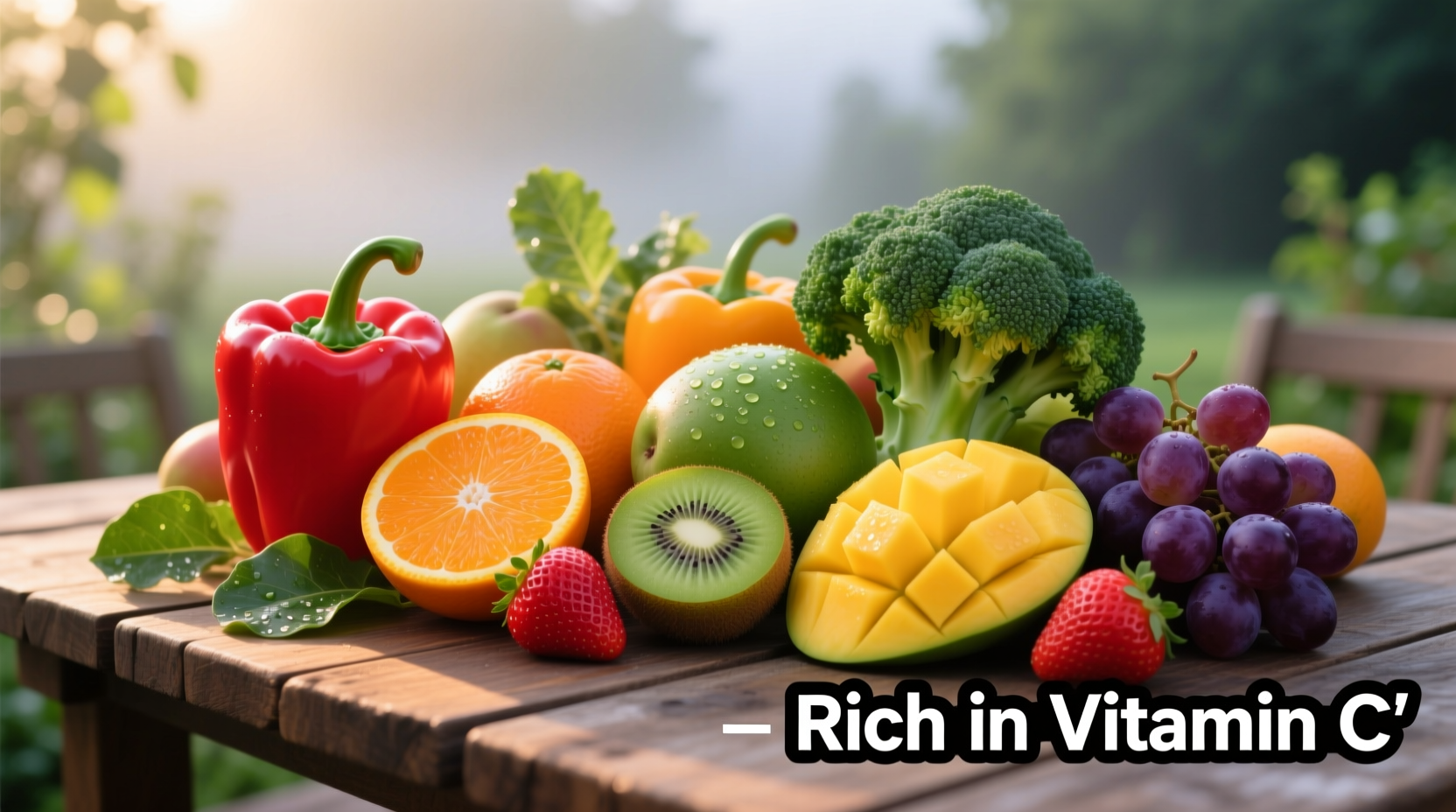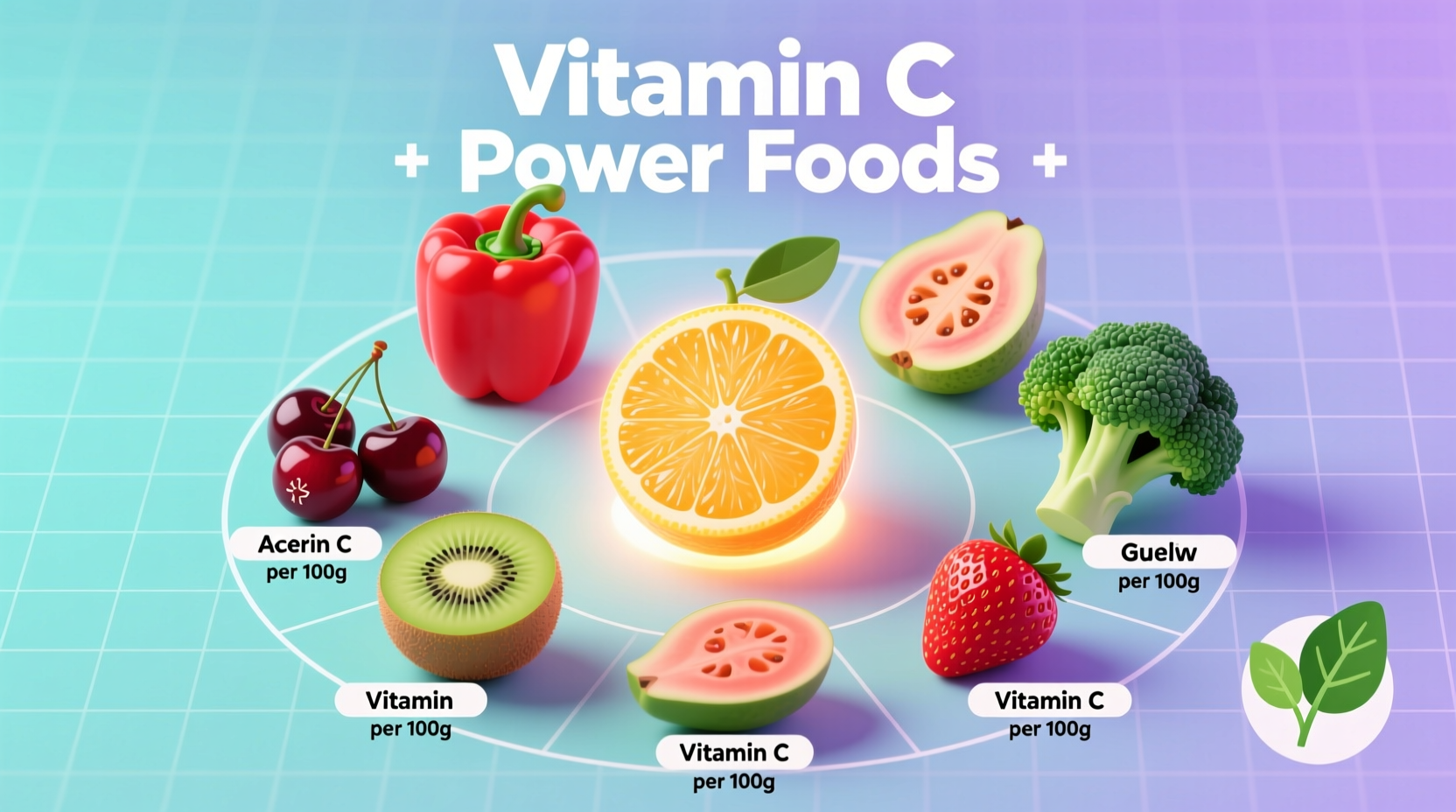The top foods highest in vitamin C include guava (377mg per 100g), bell peppers (183mg per 100g), kiwi (93mg per 100g), broccoli (89mg per 100g), and strawberries (59mg per 100g). Just one medium orange provides 70mg of vitamin C, meeting 78% of the daily recommended value for adults. These natural sources offer superior bioavailability compared to supplements and come packaged with additional nutrients that enhance absorption.
Why Vitamin C Matters More Than You Think
While most people associate vitamin C with cold prevention, this essential nutrient plays critical roles in collagen synthesis, iron absorption, and immune function. According to the National Institutes of Health, adults need 75-90mg daily, with smokers requiring an additional 35mg due to increased oxidative stress. Unlike most animals, humans cannot produce vitamin C internally, making dietary sources essential for maintaining optimal health.
| Food Source | Vitamin C (per 100g) | Daily Value % | Best Consumed |
|---|---|---|---|
| Guava | 377mg | 419% | Raw, with seeds |
| Yellow Bell Pepper | 183mg | 203% | Raw or lightly cooked |
| Kiwi | 93mg | 103% | With skin for extra fiber |
| Broccoli | 89mg | 99% | Steamed, not boiled |
| Strawberries | 59mg | 66% | Fresh, not canned |
Your Complete Guide to Vitamin C Power Foods
Fruit Powerhouses You Should Know
Citrus fruits remain popular vitamin C sources, but they're not the most potent options. One cup of chopped guava delivers over 400% of your daily needs, while a single medium kiwi provides more vitamin C than an orange. The USDA FoodData Central confirms that tropical fruits generally contain higher concentrations than temperate climate fruits. Pineapple, papaya, and cantaloupe also offer substantial amounts while providing complementary enzymes and antioxidants.

Veggie Sources That Outperform Oranges
Many vegetables contain significantly more vitamin C than citrus fruits. Bell peppers—especially yellow varieties—contain nearly three times more vitamin C per serving than oranges. Broccoli, Brussels sprouts, and cauliflower maintain impressive vitamin C levels when prepared properly. Cruciferous vegetables offer the added benefit of sulforaphane, which works synergistically with vitamin C for enhanced antioxidant effects. The key is proper preparation: boiling destroys up to 50% of vitamin C, while steaming preserves most nutrients.
Seasonal Availability and Optimal Consumption
Vitamin C content varies significantly based on ripeness, storage conditions, and season. According to research published in the Journal of Food Composition and Analysis, freshly harvested produce contains up to 30% more vitamin C than store-bought equivalents. Local farmers' markets typically offer produce with higher nutrient density compared to supermarket options that have traveled long distances. For maximum benefit, consume vitamin C-rich foods raw or minimally cooked, as heat degrades this water-soluble vitamin.
Preserving Vitamin C in Your Kitchen
How you handle foods dramatically impacts their vitamin C content. Cutting fruits and vegetables increases surface area exposed to oxygen, accelerating nutrient loss. Store cut produce in airtight containers with minimal air exposure. Avoid soaking vegetables in water, as vitamin C leaches into the liquid. When cooking, use minimal water and shorter cooking times—steaming preserves 90% of vitamin C compared to boiling's 50% retention rate. Adding acidic components like lemon juice to cut fruits creates a protective barrier against oxidation.
Special Considerations for Different Needs
Certain populations have increased vitamin C requirements. Smokers need approximately 35mg more daily due to oxidative damage from tobacco smoke. Pregnant women require 85mg, while breastfeeding mothers need 120mg. Athletes benefit from higher intake to combat exercise-induced oxidative stress. People with malabsorption conditions may need to consume more vitamin C-rich foods to meet requirements. However, exceeding 2,000mg daily can cause digestive discomfort, demonstrating that context matters when determining optimal intake levels for different individuals.
Common Vitamin C Myths Debunked
Despite popular belief, vitamin C doesn't prevent colds for most people, though it may shorten duration slightly. The Cochrane Database of Systematic Reviews confirms this limited effect after analyzing 29 trials. Another misconception: supplements equal whole food sources. Whole foods provide vitamin C within a matrix of bioflavonoids and other compounds that enhance absorption and effectiveness. Processed "vitamin C fortified" foods often contain synthetic ascorbic acid with lower bioavailability than natural sources.
Practical Daily Integration Strategies
Incorporating vitamin C-rich foods into your diet doesn't require dramatic changes. Add bell peppers to omelets, include kiwi in morning smoothies, or snack on strawberries instead of processed treats. When preparing soups or stews, add vitamin C-rich vegetables during the last 5-10 minutes of cooking to preserve nutrients. Pair vitamin C foods with iron-rich plant foods (like spinach) to enhance non-heme iron absorption by up to 67%. For optimal year-round access, freeze seasonal produce at peak ripeness—frozen fruits and vegetables often retain more nutrients than "fresh" supermarket options that have been in transit for days.











 浙公网安备
33010002000092号
浙公网安备
33010002000092号 浙B2-20120091-4
浙B2-20120091-4